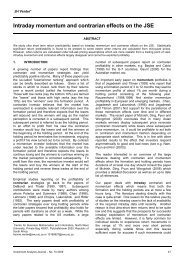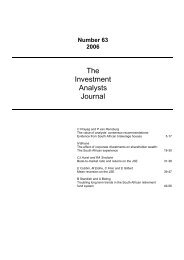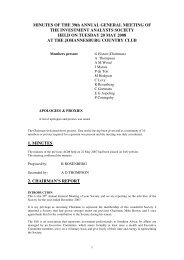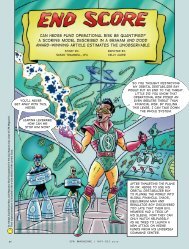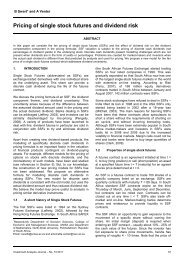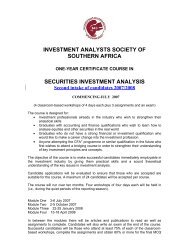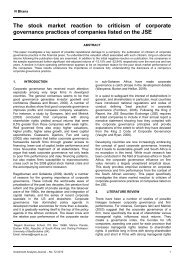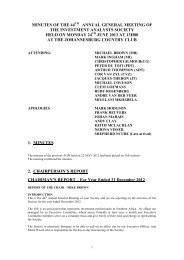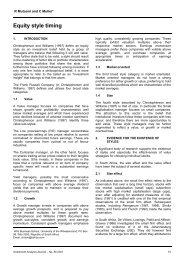Accounting is Broken - Investment Analysts Journal
Accounting is Broken - Investment Analysts Journal
Accounting is Broken - Investment Analysts Journal
Create successful ePaper yourself
Turn your PDF publications into a flip-book with our unique Google optimized e-Paper software.
Stern Stewart & Co.<br />
In year two the cost of capital component declines from $1 million to $937 thousand as the<br />
prior year’s depreciation reduces the asset bas<strong>is</strong> from $10 million to $9.373 million. As<br />
TCO remains the same each year, depreciation makes up the diff e rence. It increases fro m<br />
$627 thousand to $690 thousand.<br />
In the final analys<strong>is</strong>, only<br />
one of the three metrics<br />
can be reliably measure d<br />
with any given depre c i a-<br />
tion schedule. Policy<br />
makers must choose<br />
among operating pro f i t ,<br />
rate of re t u rn, and economic<br />
pro f i t .<br />
It <strong>is</strong> by now old news<br />
that stock options are a<br />
f o rm of compensation<br />
that should be expensed<br />
as exerc<strong>is</strong>e rights vest.<br />
Whether the option <strong>is</strong><br />
eventually exerc<strong>is</strong>ed for<br />
a gain or let lapse for a<br />
loss has nothing to do<br />
with the cost of granting<br />
the option in the first<br />
place. The true option<br />
expense <strong>is</strong> given by the<br />
o p t i o n ’s fair market<br />
value on the date of<br />
g r a n t .<br />
Repeating the exerc<strong>is</strong>e gives r<strong>is</strong>e to the table of figures. Observe that economic depre c i a-<br />
tion r<strong>is</strong>es significantly — to more than double its initial level — as the end of the asset’s life<br />
<strong>is</strong> reached and the liability to replace it looms larg e r. Notice also that the EVA profit after<br />
subtracting the 10% cost of capital from NOPAT <strong>is</strong> evenly measured each year, cons<strong>is</strong>tently<br />
sending the correct signals to managers and investors about the value of the pro j e c t .<br />
Accurately measuring EVA does re q u i re that the NOPAT earnings fall in tandem with the<br />
declining asset base. It also re q u i res an increasing rate of re t u rn to be re c o rded (but the<br />
slope of the increase <strong>is</strong> much less than with straight-line depre c i a t i o n ) .<br />
In the final analys<strong>is</strong>, only one of the three metrics can be reliably measured with any given<br />
d e p reciation schedule. Policy makers must choose among operating profit, rate of re t u rn ,<br />
and economic profit. If accounting for value <strong>is</strong> the goal, the bookkeeping system should be<br />
g e a red to measuring and re p o rting EVA, and economic depreciation schedules should be<br />
widely substituted for straight-line charts. With the advent of computers, the additional<br />
analytical complexity <strong>is</strong> now completely trivial to automate. 2 5<br />
Stock Option Grants Are An Expense<br />
It <strong>is</strong> by now old news that stock options are a form of compensation that should be expensed<br />
as exerc<strong>is</strong>e rights vest. Wa rren Buffet <strong>is</strong> finally getting h<strong>is</strong> way. Companies like The<br />
Washington Post and Coca-Cola on whose boards he sits have been among the first to<br />
adopt a new policy of recognizing the expense and expensing the options. More (maybe all)<br />
will follow.<br />
Many corporate managers have found it difficult to understand the cost of handing out<br />
options because they have collapsed two steps into one. An employee option grant <strong>is</strong> substantively<br />
the same as compensating the employee with cash — which <strong>is</strong> an obvious operating<br />
expense — and then compelling the employee to turn around and use the cash to purchase<br />
an option from the company for its fair market value — which <strong>is</strong> a separate investment<br />
dec<strong>is</strong>ion. Whether the option <strong>is</strong> eventually exerc<strong>is</strong>ed for a gain or let lapse for a loss<br />
has nothing to do with the cost of granting the option in the first place. The true option<br />
expense <strong>is</strong> given by the option’s fair market value on the date of grant. Once the option <strong>is</strong><br />
outstanding the employee becomes like any other equity holder, and the gains and loses<br />
f rom exerc<strong>is</strong>ing the option or letting it expire should not be recognized as a corporate<br />
expense or income item.<br />
Companies have been re p o rting information about stock options in their financial statement<br />
footnotes for some time, and investors have digested the news. 26<br />
Expensing options<br />
at th<strong>is</strong> time should not cause any significant revaluation of share prices, nor should it lessen<br />
f i rms’ ability to access capital — unless managers inappropriately respond to the re c o g n i-<br />
tion of an expense that they had all along.<br />
Corporate managers have long m<strong>is</strong>takenly thought of options as an inexpensive way to compensate<br />
and motivate managers and employees. They will now have the opportunity to<br />
reevaluate the effectiveness of options against other incentive plans, including cash bonus<br />
plans that attempt to simulate the incentives of ownership by sharing the economic pro f i t<br />
that <strong>is</strong> earned by a company and its business lines. 2 7<br />
2 5<br />
One caveat to that recommendation <strong>is</strong> in ord e r. Some assets may not depreciate in value at all. Prime hotel pro p e rties like the<br />
Wa l d o rf-Astoria Hotel in New York City or unique entertainment franch<strong>is</strong>es like Lion King are examples of assets that actually may<br />
a p p reciate in value over time. Charging off any depreciation in such cases d<strong>is</strong>torts the measurement of value no matter which meas<br />
u re <strong>is</strong> chosen. Accountants need to recognize the ex<strong>is</strong>tence of such assets and permit the investments in them never to be written off .<br />
2 6<br />
The EVAntage database, a joint service of Stern Stewart & Co. and Standard and Poor’s, adjusts the earnings and market value of<br />
1,300 of the largest public American companies for stock option grants.<br />
2 7<br />
See “How to Stru c t u re Incentive Plans That Work,” by G. Bennett Stewart, III, for a detailed description of EVA-based incentive<br />
contracts (available at www. s t e rn s t e w a rt.com)<br />
28




